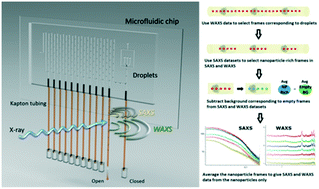An innovative data processing method for studying nanoparticle formation in droplet microfluidics using X-rays scattering†
Abstract
X-ray scattering techniques provide a powerful means of characterizing the formation of nanoparticles in solution. Coupling these techniques to segmented-flow microfluidic devices that offer well-defined environments gives access to in situ time-resolved analysis, excellent reproducibility, and eliminates potential radiation damage. However, analysis of the resulting datasets can be extremely time-consuming, where these comprise frames corresponding to the droplets alone, the continuous phase alone, and to both at their interface. We here describe a robust, low-cost, and versatile droplet microfluidics device and use it to study the formation of magnetite nanoparticles with simultaneous synchrotron SAXS and WAXS. Lateral outlet capillaries facilitate the X-ray analysis and reaction times of between a few seconds and minutes can be accommodated. A two-step data processing method is then described that exploits the unique WAXS signatures of the droplets, continuous phase, and interfacial region to identify the frames corresponding to the droplets. These are then sorted, and the background scattering is subtracted using an automated frame-by-frame approach, allowing the signal from the nanoparticles to be isolated from the raw data. Modeling these data gives quantitative information about the evolution of the sizes and structures of the nanoparticles, in agreement with TEM observations. This versatile platform can be readily employed to study a wide range of dynamic processes in heterogeneous systems.



 Please wait while we load your content...
Please wait while we load your content...